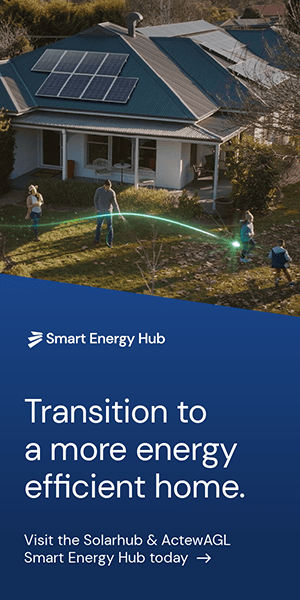ENERGY SAVINGS
Five ways to
make your
garden more
energy-efficient.
Your garden is your sanctuary and it can also be an energy saving oasis. From smart watering techniques to solar-powered garden gadgets, here we show you how to cultivate your savings and your plants.
Harness the sun with solar
Sun power goes beyond solar panels when it comes to the outdoors. Rather than use mains-powered lighting, you can invest in solar garden lights that effortlessly soak up the sun's rays during the day and cast a warm and welcoming glow at night. For ornamental water features, let solar-powered fountains or bird baths work their magic so there’s no need for a pump that uses energy.
For green-thumbed techies, consider solar-powered irrigation systems that water your plants while you relax in the hammock with a cold beer, and bask in the brilliance of a garden fully powered by the Aussie sun.
Power tool like an eco-conscious pro
Garden power tools will be one of your garden’s biggest energy consumers. Switching to energy-efficient versions can save you money. Here’s how.
Opt for cordless, rechargeable battery-powered garden tools like hedge trimmers, hedge clippers and leaf blowers. This reduces energy consumption and eliminates the need for cords and outlets. Charge them overnight during low-rate off-peak hours for extra savings. A smart irrigation system can be programmed to come on during off-peak as well, maximising irrigation efficiency by reducing water waste while maintaining plant health and quality.
When selecting power tools, look for models with high-efficiency motors that use less energy while delivering the same performance. If you fancy using some good old-fashioned elbow grease, switch to traditional hand tools like rakes or pruners that don't require electricity.
If it’s time to upgrade your mower, why not consider an electric mower? You’ll find a range of electric mowers online or at your local hardware and garden centre.
Energy-efficient pool pumps
Did you know your pool pump can account for up to 18% of your energy bill? Here are some cheeky tricks to put your pool pump on a power-saving diet. Adjust your pump runtime to match your pool's needs. For instance, running the pump for shorter periods (especially during colder months) or when the pool is not in use can significantly reduce energy consumption. Install a timer on your pool pump to schedule its operation during off-peak hours when electricity rates are lower. ACTSmart estimates doing so can reduce its energy usage by as much as 40%.
On the hunt for a new pool pump? Pay close attention to the star ratings on the Energy Rating Label to help you compare the energy efficiency of similar sized pumps. For example, a 1500-watt pump with a five-star energy rating will use more energy than a 600-watt pump with a five-star rating.
Harvest rain
Creating a garden that’s lush and green requires lots of water. Slash your bills by harvesting rainfall. With every raindrop collected, you’ll help your plants thrive while conserving a precious resource.
Consider installing rain barrels or water tanks at strategic points around your outside space to catch rainwater. Position under downspouts or gutters to maximise collection and use lids or screens to prevent pesky mosquitoes, insects and debris from contaminating the water.
If possible, connect your rain barrels or tanks to your garden's irrigation system for easy and efficient watering. Or, simply use its tap to fill up your watering can when required. Why not use your rainwater to top up water features and keep flowers blooming too?
Not to mention the flow-on effect of using more rainwater means you are less reliant on water services and are helping to lower your carbon footprint.
Position trees to heat or cool your home naturally
With some strategic tree and shrub placement, you can create both shade and windbreaks that will lower your home’s reliance on heating or cooling appliances across the seasons. Observe the sun's movement throughout the day to determine which areas of your garden receive the most sunlight and which spots are shaded. Planting tall, leafy trees on your home's southern and western sides will provide natural shade during hot afternoons and evenings when the sun is at its strongest.
The full foliage of deciduous trees near your home's windows will shade indoor space in summer, while in the winter, their leaves fall, allowing sunlight to warm your home. For wind protection, create a barrier of shrubs or low-growing plants down the side of your garden to help prevail winds without the worry of debris falling into your gutters. Doing so can reduce unwanted cold drafts and keep your outdoor areas more comfortable come autumn.
Summary
- Try out solar-powered lighting, water features and irrigation systems.
- Switch to energy-efficient power tools with batteries or use manual ones for lighter jobs.
- Run your pool pump during off-peak hours and only for shorter periods when not used often. Upgrading to an energy-efficient pool pump will help save even more.
- Install rain barrels or water tanks to harvest rain and reduce reliance on electrically powered watering devices.
- Be strategic with where you plant trees or large shrubs to offer shade or wind protection to your home.
ActewAGL's energy saving tips are designed to help you take control of your energy use, while reducing your bills and environmental impact. Save with great value energy plans backed by our sustainability promise, supported by 100% local, award-winning service - so you can LIVE A Good Life now and into the future.
For more information about how you can transition to an energy-efficient home visit the SolarHub & ActewAGL Smart Energy Hub today.
Sources
https://www.energyrating.gov.au/consumer-information/products/pool-pumps
https://www.actewagl.com.au/energy-savings/pool-pumps
https://rainwaterharvesting.org.au/
https://hopeaustralia.org.au/uploads/media/landscaping_for_energy_efficiency.pdf
Disclaimer: These Energy Savings tips and articles are for information purposes only. Please ensure you are aware of any safety precautions before operating appliances or products.



